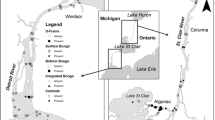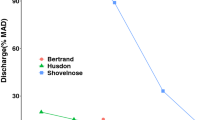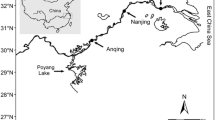Abstract
Predation during the downstream dispersal of larval stages represents a major recruitment bottleneck for fish populations. The co-occurrence of other organisms in river drift may reduce predation, but our knowledge of the factors influencing the composition and abundance of drift communities during post-hatch dispersal of larval fish remain limited. A multi-year (2011–2018) study was conducted to investigate abiotic factors influencing drift communities during larval lake sturgeon (Acipenser fulvescens) dispersal in the Upper Black River (Cheboygan, MI, USA). Cumulative water temperature was a strong predictor of drift for larval lake sturgeon, suckers (Catostomidae) and macroinvertebrates, with reduced macroinvertebrate drift during lunar phases with higher lunar illumination. Nights with a new moon had on average, three times the drifting macroinvertebrate biomass as nights during a full moon, with Heptageniidae and Isonychiidae displaying higher abundances during lower light conditions. Favorable conditions for other taxa to reduce larval lake sturgeon predation through predator swamping were common, though variability in timing (overlap between drifting taxa), biomass, and abundances likely alters the strength of such effects among years. A better understanding of the conditions influencing drifting communities during larval fish dispersal may assist in predicting larval mortality and year-class strength for managed fish populations.






Similar content being viewed by others
Data availability
The data that supports the conclusions in this paper, along with all code use in analysis is available at: https://github.com/BenbowLab/UBRDrift2020.
References
Allan, J. D., 1978. Trout predation and the size composition of stream drift. Limnology and Oceanography 23: 1231–1237.
Allan, J. D., 1987. Macroinvertebrate drift in a rocky mountain stream. Hydrobiologia 144: 261–268.
Altschul, S. F., W. Gish, W. Miller, E. W. Myers & D. J. Lipman, 1990. Basic local alignment search tool. Jounal of Molecular Biology 215: 403–410.
Angilletta, M. J., Jr., T. D. Steury & M. W. Sears, 2004. Temperature, growth rate, and body size in ectotherms: fitting pieces of a life-history puzzle. Integrative and Comparative Biology 44: 498–509.
Auer, N. & E. Baker, 2002. Duration and drift of larval lake sturgeon in the Sturgeon River, Michigan. Journal of Applied Ichthyology 18: 557–564.
Auer, N. A. & E. A. Baker, 2020. New insights into larval lake sturgeon daytime drift dynamics. Journal of Great Lakes Research 46: 339–346.
Bates, D., M. Mächler, B. Bolker & S. Walker, 2014. Fitting linear mixed-effects models using lme4. arXiv preprint arXiv: 14065823.
Baxter, C. V., T. A. Kennedy, S. W. Miller, J. D. Muehlbauer & L. A. Smock, 2017. Macroinvertebrate drift, adult insect emergence and oviposition. Methods in Stream Ecology 1: 435–456.
Beauchamp, D. A., C. M. Baldwin, J. L. Vogel & C. P. Gubala, 1999. Estimating diel, depth-specific foraging opportunities with a visual encounter rate model for pelagic piscivores. Canadian Journal of Fisheries and Aquatic Sciences 56: 128–139.
Benbow, M. E., J. P. Receveur & G. A. Lamberti, 2020. Death and decomposition in aquatic ecosystems. Frontiers in Ecology and Evolution 8: 17.
Benbow, M. E., J. P. Receveur & S. Nowak, 2019. An overview of the aquatic insect ecological tables. In Merritt, R.W., K.W. Cummins & M.B. Berg (eds). An Introduction to the Aquatic Insects of North America. Kendall Hunt, Dubuque, Iowa: 165–174.
Benjamini, Y. & Y. Hochberg, 1995. Controlling the false discovery rate: a practical and powerful approach to multiple testing. Journal of the Royal Statistical Society 57: 289–300.
Benke, A. C., A. D. Huryn, L. A. Smock & J. B. Wallace, 1999. Length-mass relationships for freshwater macroinvertebrates in North America with particular reference to the southeastern United States. Journal North American Benthological Society 18: 308–343.
Bridcut, E., 2000. A study of terrestrial and aerial macroinvertebrates on river banks and their contribution to drifting fauna and salmonid diets in a Scottish catchment. Hydrobiologia 427: 83–100.
Brittain, J. E. & T. J. Eikeland, 1988. Invertebrate drift—a review. Hydrobiologia 166: 77–93.
Brooks, M. E., K. Kristensen, K. J. van Benthem, A. Magnusson, C. W. Berg, A. Nielsen, H. J. Skaug, M. Machler & B. M. Bolker, 2017. glmmTMB balances speed and flexibility among packages for zero-inflated generalized linear mixed modeling. The R Journal 9: 378–400.
Bruch, R. M. & F. Binkowski, 2002. Spawning behavior of lake sturgeon (Acipenser fulvescens). Journal of Applied Ichthyology 18: 570–579.
Caroffino, D. C., T. M. Sutton, R. F. Elliott & M. C. Donofrio, 2010. Predation on early life stages of lake sturgeon in the Peshtigo River, Wisconsin. Transactions of the American Fisheries Society 139: 1846–1856.
Carpenter, J. & G. A. Mueller, 2008. Small nonnative fishes as predators of larval razorback suckers. The Southwestern Naturalist 53: 236–242.
Copp, G., S. Spathari & M. Turmel, 2005. Consistency of diel behaviour and interactions of stream fishes and invertebrates during summer. River Research and Applications 21: 75–90.
Crossman, J. A., K. T. Scribner, P. S. Forsythe & E. A. Baker, 2018. Lethal and non-lethal effects of predation by native fish and an invasive crayfish on hatchery-reared age-0 lake sturgeon. Journal of Applied Ichthyology. 34: 322–330.
Crossman, J. A., K. T. Scribner, D. T. Yen, C. A. Davis, P. S. Forsythe & E. A. Baker, 2011. Gamete and larval collection methods and hatchery rearing environments affect levels of genetic diversity in early life stages of lake sturgeon (Acipenser fulvescens). Aquaculture 310: 312–324.
Culp, J. M. & G. J. Scrimgeour, 1993. Size-dependent diel foraging periodicity of a mayfly grazer in streams with and without fish. Oikos 68: 242–250.
Delm, M. M., 1990. Vigilance for predators: detection and dilution effects. Behavioral Ecology and Sociobiology 26: 337–342.
Diehl, S., 1988. Foraging efficiency of three freshwater fishes: effects of structural complexity and light. Oikos 53: 207–214.
Doretto, A., E. Piano, E. Falasco, S. Fenoglio, M. Bruno & F. Bona, 2018. Investigating the role of refuges and drift on the resilience of macroinvertebrate communities to drying conditions: an experiment in artificial streams. River Research and Applications 34: 777–785.
Doretto, A., J. P. Receveur, E. A. Baker, M. E. Benbow & K. T. Scribner, 2022. Nested analysis of macroinvertebrate diversity along a river continuum: Identifying relevant spatial scales for stream communities. River Research and Applications 38: 334–344.
Duong, T. Y., K. T. Scribner, J. A. Crossman, P. S. Forsythe & E. A. Baker, 2011. Environmental and maternal effects on embryonic and larval developmental time until dispersal of lake sturgeon (Acipenser fulvescens). Canadian Journal of Fisheries and Aquatic Science 68: 643–654.
Fasiolo, M., R. Nedellec, Y. Goude & S. N. Wood, 2019. Scalable visualisation methods for modern generalized additive models. Journal of Computational and Graphical Statistics 29: 78–86.
Fenoglio, S., T. Bo, G. Gallina & M. Cucco, 2004. Vertical distrubution in the water column of drifting stream macroinvertebrates. Journal of Freshwater Ecology 19: 485–492.
Fenoglio, S., F. Boano, T. Bo, R. Revelli & L. Ridolfi, 2013. The impacts of increasing current velocity on the drift of Simulium monticola (Diptera: Simuliidae): a laboratory approach. Italian Journal of Zoology 80: 443–448.
Flecker, A. S., 1992. Fish predation and the evolution of invertebrate drift periodicity: evidence from neotropical streams. Ecology 73: 438–448.
Forrester, G. E., 1994. Influences of predatory fish on the drift dispersal and local density of stream insects. Ecology 75: 1208–1218.
Forsythe, P., K. Scribner, J. Crossman, A. Ragavendran & E. Baker, 2013. Experimental assessment of the magnitude and sources of lake sturgeon egg mortality. Transactions of the American Fisheries Society 142: 1005–1011.
Forsythe, P., K. Scribner, J. Crossman, A. Ragavendran, E. Baker, C. Davis & K. Smith, 2012. Environmental and lunar cues are predictive of the timing of river entry and spawning-site arrival in lake sturgeon Acipenser fulvescens. Journal of Fish Biology 81: 35–53.
Forsythe, P. S., J. A. Crossman, N. M. Bello, E. A. Baker & K. T. Scribner, 2011. Individual-based analyses reveal high repeatability in timing and location of reproduction in lake sturgeon (Acipenser fulvescens). Canadian Journal of Fisheries and Aquatic Sciences 69: 60–72.
Furey, N. B., S. G. Hinch, A. L. Bass, C. T. Middleton, V. Minke-Martin & A. G. Lotto, 2016. Predator swamping reduces predation risk during nocturnal migration of juvenile salmon in a high-mortality landscape. Journal of Animal Ecology 85: 948–959.
Gadomski, D. M. & M. J. Parsley, 2005. Effects of turbidity, light level, and cover on predation of white sturgeon larvae by prickly sculpins. Transactions of the American Fisheries Society 134: 369–374.
Gibbins, C., D. Vericat, R. Batalla & C. Buendia, 2016. Which variables should be used to link invertebrate drift to river hydraulic conditions? Fundamental and Applied Limnology 187: 191–205.
Hamilton, W. D., 1971. Geometry for the selfish herd. Journal of Theoretical Biology 31: 295–311.
Hansen, E. A. & G. P. Closs, 2007. Temporal consistency in the long-term spatial distribution of macroinvertebrate drift along a stream reach. Hydrobiologia 575: 361–371.
Hartig, F., 2017. DHARMa: residual diagnostics for hierarchical (multi-level/mixed) regression models. R Package Version 01: 5.
Hay, C. H., T. G. Franti, D. B. Marx, E. J. Peters & L. W. Hesse, 2008. Macroinvertebrate drift density in relation to abiotic factors in the Missouri River. Hydrobiologia 598: 175–189.
Huhta, A., T. Muotka & P. Tikkanen, 2000. Nocturnal drift of mayfly nymphs as a post-contact antipredator mechanism. Freshwater Biology 45: 33–42.
Hynes, H., 1970. The ecology of stream insects. Annual Review of Entomology 15: 25–42.
Imbert, J. B. & J. A. Perry, 2000. Drift and benthic invertebrate responses to stepwise and abrupt increases in non-scouring flow. Hydrobiologia 436: 191–208.
Ims, R. A., 1990. On the adaptive value of reproductive synchrony as a predator-swamping strategy. The American Naturalist 136: 485–498.
Ivanova, N. V., T. S. Zemlak, R. H. Hanner & P. D. Hebert, 2007. Universal primer cocktails for fish DNA barcoding. Molecular Ecology Notes 7: 544–548.
Kassambara, A., 2017. ggpubr:“ggplot2” based publication ready plots. R Package Version 01: 6.
Kempinger, J. J., 1988. Spawning and early life history of lake sturgeon in the Lake Winnebago system, Wisconsin. American Fisheries Society Symposium 5: 110–112.
Koetsier, P. & C. F. Bryan, 1992. Diel, size-differential drift patterns of three macroinvertebrate species in the lower Mississippi River, Louisiana (USA). Hydrobiologia 228: 225–230.
Koetsier, P. & C. F. Bryan, 1995. Effects of abiotic factors on macroinvertebrate drift in the lower Mississippi river, Louisiana. American Midland Naturalist 134: 63–74.
Lechner, A., H. Keckeis & P. Humphries, 2016. Patterns and processes in the drift of early developmental stages of fish in rivers: a review. Reviews in Fish Biology and Fisheries 26: 471–489.
Marra, G. & S. N. Wood, 2012. Coverage properties of confidence intervals for generalized additive model components. Scandinavian Journal of Statistics 39: 53–74.
McMurdie, P. J. & S. Holmes, 2013. phyloseq: An R package for reproducible interactive analysis and graphics of microbiome census data. Plos One 8: e61217.
McPhee, J. J., M. E. Platell & M. J. Schreider, 2015. Trophic relay and prey switching–a stomach contents and calorimetric investigation of an ambassid fish and their saltmarsh prey. Estuarine Coastal and Shelf Science 167: 67–74.
Merritt, R. W., K. W. Cummins & M. B. Berg, 2008. An introduction to the aquatic insects of North America, 4th ed. Kendall Hunt Publishing Company:
Miller, S. W., & Judson, S. 2014. Responses of macroinvertebrate drift, benthic assemblages, and trout foraging to hydropeaking. Canadian Journal of Fisheries and Aquatic Sciences 71: 675–687
Murdoch, W. W., 1969. Switching in general predators: experiments on predator specificity and stability of prey populations. Ecological Monographs 39: 335–354.
Naman, S. M., J. S. Rosenfeld & J. S. Richardson, 2016. Causes and consequences of invertebrate drift in running waters: from individuals to populations and trophic fluxes. Canadian Journal of Fisheries and Aquatic Science 73: 1292–1305.
Neuswanger, J., M. S. Wipfli, A. E. Rosenberger & N. F. Hughes, 2014. Mechanisms of drift-feeding behavior in juvenile Chinook salmon and the role of inedible debris in a clear-water Alaskan stream. Environmental Biology of Fishes 97: 489–503.
O’Connor, J., E. Fobert, M. Besson, H. Jacob & D. Lecchini, 2019. Live fast, die young: Behavioural and physiological impacts of light pollution on a marine fish during larval recruitment. Marine Pollution Bulletin 146: 908–914.
Peckarsky, B. L., 1982. Aquatic insect predator-prey relations. Bioscience 32: 261–266.
Pepin, P., 2009. The impacts of environmental change and ecosystem structure on the early life stages of fish: a perspective on establishing predictive capacity the future of fisheries science in North America. In The future of fisheries science in North America. Springer.
Perkin, E. K., F. Hölker, K. Tockner & J. S. Richardson, 2014. Artificial light as a disturbance to light-naïve streams. Freshwater Biology 59: 2235–2244.
Peterson, D. L., P. Vecsei & C. A. Jennings, 2007. Ecology and biology of the lake sturgeon: a synthesis of current knowledge of a threatened North American Acipenseridae. Reviews in Fish Biology and Fisheries 17: 59–76.
Pinheiro, J., D. Bates, S. DebRoy, D. Sarkar & R. C. Team, 2012. nlme: linear and nonlinear mixed effects models, R package versio, 3(0):
Pledger, S., E. Baker & K. Scribner, 2013. Breeding return times and abundance in capture–recapture models. Biometrics 69: 991–1001.
R Core Team, 2021. R: a language and environment for statistical computing, R Foundation for Statistical Computing, Vienna, Austria:
Reiss, K., M. B. Herriot & B. K. Eriksson, 2014. Multiple fish predators: effects of identity, density, and nutrients on lower trophic levels. Marine Ecological Progress Series 497: 1–12.
Rosenfeld, J. S., N. Bouwes, C. E. Wall & S. M. Naman, 2014. Successes, failures, and opportunities in the practical application of drift-foraging models. Environmental Biology of Fishes 97: 551–574.
Sánchez-Hernández, J., A. G. Finstad, J. V. Arnekleiv, G. Kjærstad & P.-A. Amundsen, 2020. Beyond ecological opportunity: Prey diversity rather than abundance shapes predator niche variation. Freshwater Biology 66: 44–61.
Schiemer, F., H. Keckeis & E. Kamler, 2002. The early life history stages of riverine fish: ecophysiological and environmental bottlenecks. Comparative Biochemistry and Physiology Part A: Molecular & Integrative Physiology 133: 439–449.
Schindelin, J., C. T. Rueden, M. C. Hiner & K. W. Eliceiri, 2015. The ImageJ ecosystem: an open platform for biomedical image analysis. Molecular Reproduction and Development 82: 518–529.
Simpson, G., 2019. gratia: graceful’ggplot’-based graphics and other functions for GAMs fitted using “mgcv,” R package version 0.2-8:
Smith, K. & D. King, 2005. Dynamics and extent of larval lake sturgeon Acipenser fulvescens drift in the Upper Black River, Michigan. Journal of Applied Ichthyology 21: 161–168.
Tabor, R. A., G. S. Brown & V. T. Luiting, 2004. The effect of light intensity on sockeye salmon fry migratory behavior and predation by cottids in the Cedar River, Washington. North American Journal of Fisheries Management 24: 128–145.
Tamura, K., G. Stecher, D. Peterson, A. Filipski & S. Kumar, 2013. MEGA6: molecular evolutionary genetics analysis version 6.0. Molecular Biology and Evolution 30: 2725–2729.
Taylor, J., B. North, M. Porter, N. Bromage & H. Migaud, 2006. Photoperiod can be used to enhance growth and improve feeding efficiency in farmed rainbow trout, Oncorhynchus mykiss. Aquaculture 256: 216–234.
Van Rij, J., M. Wieling, R. H. Baayen & H. Van Rijn, 2017. itsadug: interpreting time series and autocorrelated data using GAMMs, R package version 2:
Waraniak, J., S. Valentine & K. Scribner, 2017. Effects of changes in alternative prey densities on predation of drifting lake sturgeon larvae (Acipenser fulvescens). Journal of Freshwater Ecology 32: 619–632.
Waraniak, J. M., E. A. Baker & K. T. Scribner, 2018. Molecular diet analysis reveals predator–prey community dynamics and environmental factors affecting predation of larval lake sturgeon Acipenser fulvescens in a natural system. Journal of Fish Biology 93: 616–629.
Waraniak, J. M., T. L. Marsh & K. T. Scribner, 2019. 18S rRNA metabarcoding diet analysis of a predatory fish community across seasonal changes in prey availability. Ecology and Evolution 9: 1410–1430.
Waters, T. F., 1961. Standing crop and drift of stream bottom organisms. Ecology 42: 532–537.
Waters, T. F., 1962. Diurnal periodicity in the drift of stream invertebrates. Ecology 43: 316–320.
Waters, T. F., 1966. Production rate, population density, and drift of a stream invertebrate. Ecology 47: 595–604.
Waters, T. F., 1972. The drift of stream insects. Annual Review of Entomology 17: 253–272.
Wickham, H., W. Chang & M. H. Wickham, 2016. Package ‘ggplot2,’ Create Elegant Data Visualisations Using the Grammar of Graphics Version 2:
Wiley, M. & S. L. Kohler, 1984. Behavioral adaptations of aquatic insects: the ecology of aquatic insects, Praeger, New York:
Wood, S. N., 2011. Fast stable restricted maximum likelihood and marginal likelihood estimation of semiparametric generalized linear models. Journal Royal Statistical Society Series B (Stat Method) 73: 3–36.
Acknowledgements
We would like to thank the Black River lake sturgeon field crews (2011–2018) who assisted with sample collection and taxonomic identification, without which this study would not have been possible. Members of the Scribner lab and three anonymous reviewers provided valuable comments which improved the paper.
Funding
Funding was provided by the Michigan Department of Natural Resources, The Great Lakes Fishery Trust, the U.S. Fish and Wildlife Service Coastal Program, and Michigan State University Ag Bio Research.
Author information
Authors and Affiliations
Contributions
This study was conceived, designed, and supervised by KTS, EAB, JB, and MEB. KS and EB wrote the grants that funded this project. Data collection, data aggregation, and initial analysis were performed by DL and RW. Formal data analysis and first draft of the manuscript were completed by JPR and AD.
Corresponding author
Ethics declarations
Conflict of interest
The authors have no competing interests to declare.
Additional information
Handling editor: Antti P. Eloranta
Publisher's Note
Springer Nature remains neutral with regard to jurisdictional claims in published maps and institutional affiliations.
Supplementary Information
Below is the link to the electronic supplementary material.
Rights and permissions
Springer Nature or its licensor holds exclusive rights to this article under a publishing agreement with the author(s) or other rightsholder(s); author self-archiving of the accepted manuscript version of this article is solely governed by the terms of such publishing agreement and applicable law.
About this article
Cite this article
Receveur, J.P., Doretto, A., Baker, E.A. et al. Riverine drift communities during larval fish dispersal over multiple recruitment years. Hydrobiologia 849, 4357–4375 (2022). https://doi.org/10.1007/s10750-022-04995-6
Received:
Revised:
Accepted:
Published:
Issue Date:
DOI: https://doi.org/10.1007/s10750-022-04995-6




